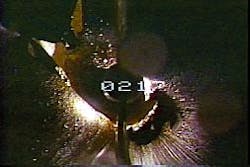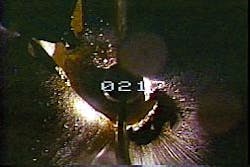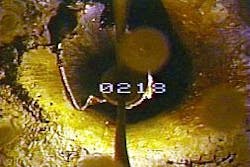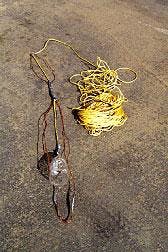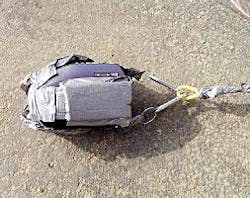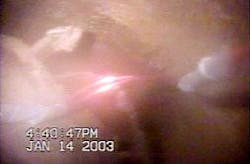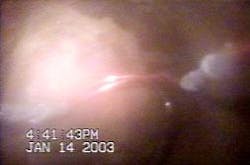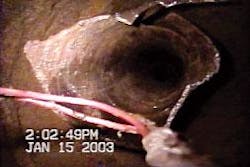Donald G. Nelson
Vaquero Energy Inc.
Edison, Calif.
Movie images obtained with an off-the-shelf camcorder deployed on the end of a rope greatly reduced the time and cost associated with fishing and casing repair of a severely damaged shallow heavy-oil well in a cyclic-steam project.
The well, Vaquero Energy Inc.'s Young Fee K2-2, is in Edison field in California's San Joaquin basin.
Inadequate information about the physical nature of subsurface damage often complicates pipe recovery and remedial operations. These uncertainties increase risk and cost, and as a result many remedial jobs fail, are over expended, or are never attempted.
The industry has tools for obtaining downhole information, but often these tools are expensive. For instance, smaller operating companies often find running conventional downhole video inspections from both oil field and water-well service companies excessively expensive.
Also impression blocks or casing and tubing inspection logs are costly and usually result in an incomplete definition of the downhole problem.
Problem encountered
Young Fee K2-2 was drilled and gravel packed as a Miocene sand producer in the 1950s. As with many local wells of Korean War vintage, the well casing was non-API, thin 85/8 in., 24 lb/ft converted line pipe in short 20-ft lengths.
Conventional wireline video shows the collapsed and parted upper casing section, on photo above, and the lower casing section, on photo below(Fig. 1).
It was estimated that no cement was behind the casing from roughly 1,600 ft to surface.
In March 2000, a recompletion plugged back the well with sand to 2,370 ft and placed new perforations into the Lower Kern River zone between 1,998 and 2,142 ft.
The job included setting a thermal packer and expansion joint at 1,982-ft, prior to moving in a portable steam generator for a 10,000 bbl-cwe (cold-water equivalent) cyclic-steam project. After operating for 1 day, the generator had to be shut down because the tubing pressure suddenly dropped to 100 psi from 700 psi.
To determine what may have happened, Vaquero first ran a wireline feeler that could not pass 210 ft. It then attempted to pull the packer but the tubing parted at 210 ft.
A conventional video logging run showed collapsed and parted casing (Fig. 1), but the loggers were unable to inspect the top of the tubing fish.
The deployed system included rope, copper wire, plastic bottle, clips, above photo, and the camcorder covered with felt wicks and duct tape, photo below (Fig. 2).
Vaquero then delayed repairing the well because of the risk and uncertainty. Options considered included swedging, milling, and pulling to recover the upper piece of casing. Vaquero felt the chances of success were low and expected the workover would turn into an abandonment project.
Repair work
In January 2003, the job to repair the well finally began.
The first step successfully worked a swedge through the collapsed part of the upper section to expand the casing. When progress ended, the swedge was pulled and it was noted that stuck to it was sand, indicating that the swedge had gone outside of the lower casing section.
To determine a new approach for gaining entry to the lower casing section, Vaquero purchased a 250-ft rope and Panasonic PV-L352 camcorder at local electronics and hardware stores in Bakersfield, Calif.
On Jan. 14, 2003, Vaquero deployed this downhole inspection assembly that included the VHS-C tape camcorder with integral light. The assembly also had bare No. 6 copper wire as a makeshift centralizer and reentry guide, as well as a plastic juice bottle that acted as a shroud to keep the camera clean (Fig. 2, left photo).
Shower-curtain and metal hooks connected the end of the rope to the camcorder, and felt oil-well oiler wicks provided padding for protecting the camcorder. Duct tape held everything together (Fig. 2, right photo).
The work crew placed the rope over a small sheave and lowered the camcorder assembly by hand. The conventional video logging run in March 2000 had indicated that the fluid level was below the problem spot.
Vaquero felt that there was little risk of an explosive atmosphere downhole because the well had a packer downhole, the amount of steam and water injected previously, and the lack of gas pressure after a 3-year shut in.
Also, although the camcorder is not explosion-proof, the camcorder was run in the well while being switched on, thus lessening the risk of creating a spark. Vaquero did consider the log run as "hot work" and held a safety meeting prior to the operation.
The images from the first run showed that the swedge successfully opened the upper casing section and that a large piece of casing was bent over the lower casing section blocking entry of the swedge and camcorder (Fig. 3, top two photos).
The camcorder showed the lower casing section blocked by bent casing, photos above and below.
null
The lower casing section reopened, above photo.
The top of tubing fish, above photo (Fig. 3).
Based on the image, Vaquero decided to run a fish-tail bit in an attempt to pry open the lower casing section.
The images from the next run showed that the fish-tail bit successfully opened up the lower casing section (Fig. 3, upper photo). The camcorder then successfully entered the lower casing section and showed that the tubing fish was in a condition and position that would allow it to be retrieved with an overshot, sizing mill, and grapple (Fig. 3, lower photo).
After the tubing fish and packer were retrieved, the job included setting a cast-iron bridge plug at 1,920 ft. This was followed by running a string of 51/2-in. casing to 1,910-ft and cementing it to surface.
The final steps in recompleting the well were:
Cut off old wellhead from the 85/8-in. casing and weld on a new wellhead to the 51/2-in. casing.
Drill out bridge plug.
Run in tubing and prepare to steam-cycle the well.
Vaquero expects the repair will greatly extend the life and economic value of the well.
After three downhole runs, the camcorder is still usable for a variety of applications. Total cost of the work was about $42,000 including $280 for the camcorder and about $20,000 for rig time.
The author
Donald G. Nelson is vice-president and production manager for Vaquero Energy, Inc., Edison, Calif. He previously worked for Chevron Corp. in various engineering, operations, research, and training assignments. Nelson holds a BS in petroleum engineering from Stanford University and is a registered professional engineer in California.
